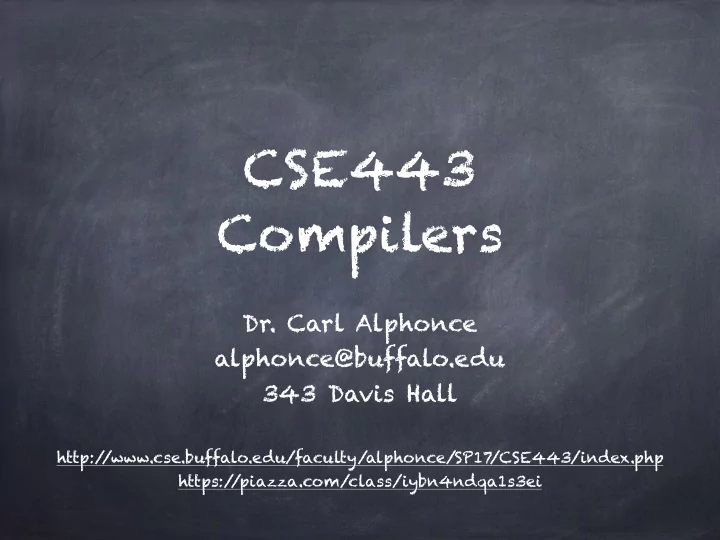

CSE443 Compilers Dr. Carl Alphonce alphonce@buffalo.edu 343 Davis Hall http:/ /www.cse.buffalo.edu/faculty/alphonce/SP17 /CSE443/index.php https:/ /piazza.com/class/iybn4ndqa1s3ei
Syllabus Posted on website Covered most last class Academic Integrity
Departmental Policy on Violations of Academic Integrity (AI) The CSE Department has a zero-tolerance policy regarding academic integrity (AI) violations. When there is a potential violation of academic integrity in a course, the course director shall first notify the concerned students. This notification begins the review and appeals process defined in the University's Academic Integrity statement: http:/ /catalog.buffalo.edu/policies/course/integrity.html Upon conclusion of the review and appeals process, if the department, school, and university have determined that the student has committed a violation, the following sanctions will be imposed upon the student: § 1. Documentation. The department, school, and university will record the student's name in departmental, decanal, and university-level academic integrity violations databases. § 2. Penalty Assessment. The standing policy of the Department is that all students involved in an academic integrity violation will receive an F grade for the course. The course director may recommend a lesser penalty for the first instance of academic integrity violation, and the adjudication committees that hear the appeal at the department, decanal and provost level may recommend a lesser or greater penalty.
Lexical Phases of structure a compiler Figure 1.6, page 5 of text
Lexical Analysis Lexical structure described by regular grammar Deterministic finite state machine performs analysis
LANGUAGE operations If L and M are regular, so are: L ∪ M = { s | s ∈ L or s ∈ M } union LM = { st | s ∈ L and t ∈ M } concatenation L * = ∪ i=0, ∞ L i Kleene closure By definition, L 0 = { ℇ }
Given an alphabet ∑ REGular EXpression (regex) Inductive definition ℇ is a regex 𝓜 ( ℇ ) = { ℇ } For each a ∈ ∑ , a is a regex 𝓜 (a) = {a}
Regular expressions (regex) Inductive definition Assume r and s are regexes. r|s is a regex denoting 𝓜 (r) ∪ 𝓜 (s) rs is a regex denoting 𝓜 (r) 𝓜 (s) * is a regex denoting ( 𝓜 (r)) * r (r) is a regex denoting 𝓜 (r) Precedence: Kleene closure > concatenation > union Associativity: all left-associative (minimize use of parentheses: (r|s)|t = r|s|t )
Algebraic laws Assume r and s are regexes. Commutativity r|s = s|r Associativity r|(s|t) = (r|s)|t and r(st) = (rs)t Disributivity r(s|t) = rs|rt and (s|t)r = sr|tr Identity ℇ r = r ℇ = r Idempotency r ** = r *
We can describe a regular language using a regular expression
A regular expression can be recognized using a finite state machine. Machines: NFA non-deterministic finite automaton DFA deterministic finite automaton
Process of building lexical analyzer 1) spell out the language language
Process of building lexical analyzer 2) formulate a regular expression language regex
Process of building lexical analyzer 3) build an NFA language regex NFA
Process of building lexical analyzer 4) transform NFA to DFA language regex NFA DFA
Process of building lexical analyzer 5) transform DFA to a minimal DFA language regex NFA DFA DFA
Process of building lexical analyzer 5) The minimal DFA is character our lexical analyzer stream language regex NFA DFA DFA token stream lexical analyzer
Focus for today regex NFA
Nondeterministic Finite Automata (NFA) A finite set of states S An alphabet ∑ , ℇ ∉ ∑ 𝛆 ⊆ S X ( ∑ ∪ { ℇ }) X 𝒬 (S) (transition function) s 0 ∈ S (a single start state) F ⊆ S (a set of final or accepting states)
Deterministic Finite Automata (DFA) A finite set of states S An alphabet ∑ , ℇ ∉ ∑ 𝛆 ⊆ S X ∑ X S (transition function) s 0 ∈ S (a single start state) F ⊆ S (a set of final or accepting states)
Regex -> NFA ℇ 1 0 N(s) ℇ ℇ 0 1 ℇ ℇ N(t) a 1 0 S | t for each a ∈ ∑
Regex -> NFA St 0 1 N(s) N(t) ℇ ℇ S * 0 1 N(s) ℇ ℇ
Simple example static
Simple example static c s t a t i 0 1 2 3 4 5 6
Simple example static struct c s a t i t ℇ 0 1 2 3 4 5 6 ℇ i F t s t r u c ℇ ℇ 7 8 9 10 11 12 13
Recommend
More recommend